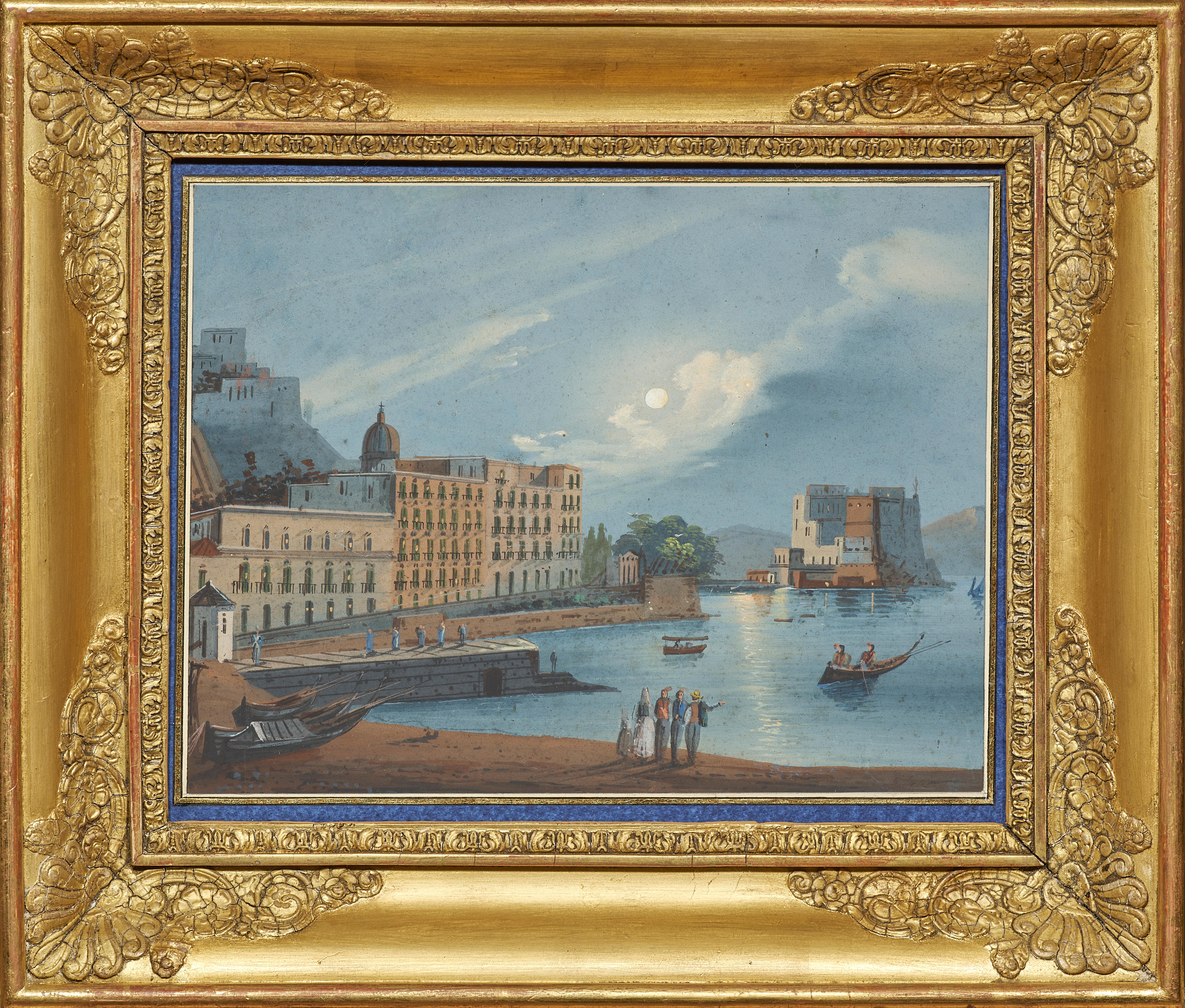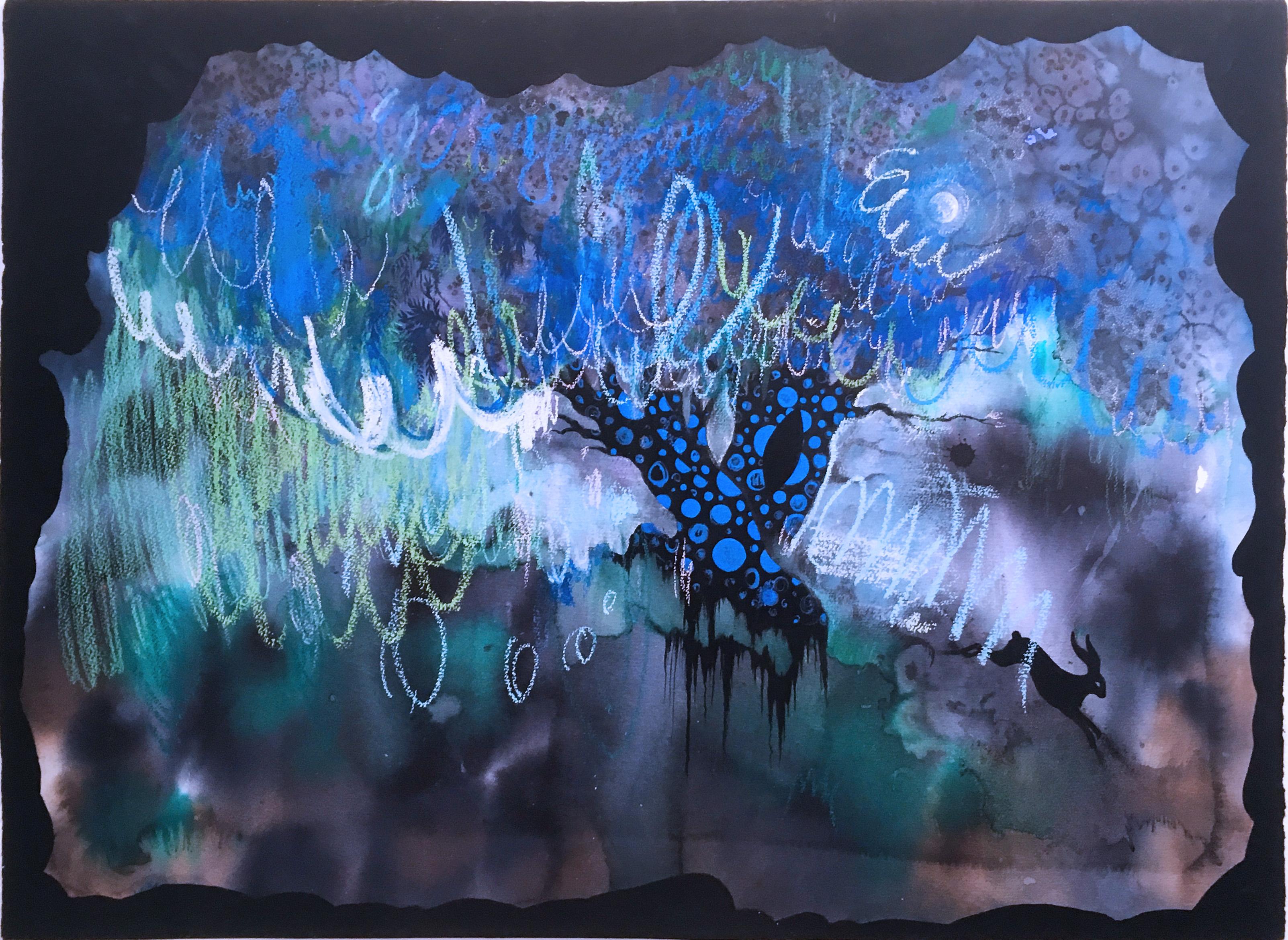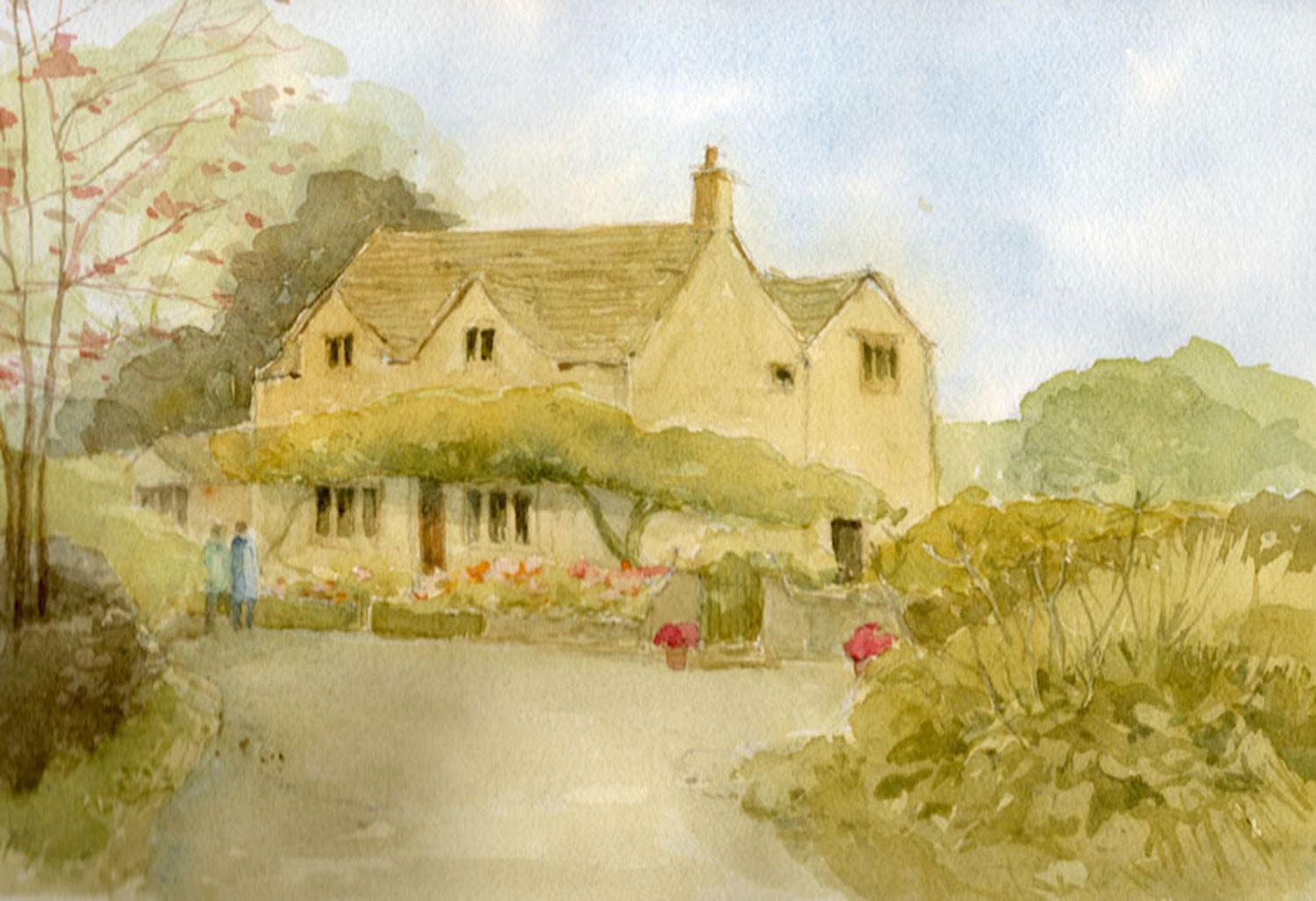Items Similar to View of Ariccia, a preparatory drawing by Achille Bénouville (1815 - 1891)
Want more images or videos?
Request additional images or videos from the seller
1 of 8
Jean-Achille BenouvilleView of Ariccia, a preparatory drawing by Achille Bénouville (1815 - 1891)1851
1851
About the Item
This very modern drawing presents a view of Ariccia, a small town 25 kilometres south-east of Rome. The Palazzo Chigi (in which the film-maker Luchino Visconti would film a large part of The Leopard a century later) and the adjoining church are seen from the bottom of the ravine that surrounds the town. This drawing is a moving testimony to the attraction of the city for artists of the Romantic period, who established in Ariccia a vivid artists' colony.
1. Achille Bénouville, a French landscape painter in Italy
Achille Bénouville is probably the main representative of what could be defined as the third (and, so to speak, last) generation of neo-classical and/or historical landscape painters. Born in the 1810s and 1820s, Félix Lanoue, Paul Flandrin, Eugène Ferdinand Buttura or Alfred de Curzon are Bénouville’s contemporaries.
A pupil of François-Edouard Picot (1786 - 1868) and then of Léon Cogniet (1794 - 1880), Bénouville quickly specialised in landscape painting, starting with views of the Paris basin, which he exhibited at the 1834 Salon. He visited Italy three times, in 1838, 1840 and 1843. During his last trip in 1843, he became friends with Jean-Baptiste Corot (1796 - 1875) and shared his Roman studio.
After winning the historical landscape prize in 1845 (the same year his brother Léon won the Grand Prix de Rome for painting), he returned to Italy to spend three years at the Villa Medici. He then settled in Italy for 25 years, until the death of his wife in 1870, an event that led to his return to France.
2. Description of the artwork
From a viewpoint located below the town, the artist depicts the main monuments of Ariccia: the Chigi Palace and the adjoining church, the monumental access bridge.
The Chigi Palace was built between 1664 and 1672 by the Chigi family, which was at the height of its power thanks to the pontificate of Alexander VII (1655 - 1667). Carlo Fontana was the architect who supervised the transformation of an earlier fortress, based on a project by Giovan Lorenzo Bernini, who also designed the Maria Assunta Church opposite.
The small town, which stands on a hilltop, is surrounded by deep ravines, which explains the construction in the mid-19th century of the monumental access bridge one can see on the left.
This view taken from below shows the city in a backlight which the artist has rendered with great economy of means. The city stands out against a bluish sky suggested by a thin highlight of gouache. Only the shadows are drawn with a grey wash, while the rest of the ochre-coloured paper remains unpainted.
3. Related artworks
While some older drawings demonstrate that Bénouville visited Ariccia well before 1851, it seems to us that our drawing can be regarded as a preparatory drawing, probably executed in the open air, for the much more accomplished drawing from the Metropolitan Museum in New York (last image in the gallery). The latter was done in brown ink wash with watercolour highlights and bears the signature "Ach. Bénouville Roma 53", which clearly indicates that it was made at a later stage in the artist's Roman studio.
4. Ariccia, an artists' colony at the gates of Rome
The fame of Ariccia in the Romantic period was largely based on the attractiveness of the Locanda Martorelli, the inn located in the square in front of the palace, which was a popular stop on the road to Naples during the Grand Tour. This inn later became a holiday resort attracting the entire Romantic generation, both writers and painters. Artists as diverse as J.M. William Turner (1775 - 1851), Jean-Baptiste Corot (1796 - 1875) and Henrik Ibsen (1826 - 1906), who wrote his play Brand here in 1865, stayed there.
It is interesting in this respect to compare this drawing to the view of Ariccia painted in 1826-1827 by Jean-Baptiste Corot (with whom Bénouville shared a studio in Rome in 1843). In this painting Corot presents a viewpoint quite similar to that of our drawing, also in a backlight, at a time when the monumental access bridge had not yet been built.
5. Framing
The drawing has been given new margins and is presented in a 19th century natural wood frame with light fillets. The blue of the marie-louise has been chosen to match the thin gouache highlights of the sky.
Main bibliographical references :
Marie-Madeleine Aubrun Achille Benouville 1851-1891. Paris, 1986
- Creator:Jean-Achille Benouville (1815 - 1891, French)
- Creation Year:1851
- Dimensions:Height: 8.44 in (21.44 cm)Width: 11 in (27.94 cm)
- Medium:
- Movement & Style:
- Period:
- Condition:Grey ink wash and gouache over pencil lines Signed and dated lower left "Bénouville Ariccia 51” 8 7/16’’ x 11” (215 x 280 mm) – Framed : 14 5/16”x 16 7/8” (36.4 cm x 42.8 cm) Provenance: Ullmann collection (stamp) 19th century dark wood frame.
- Gallery Location:PARIS, FR
- Reference Number:1stDibs: LU1568210961182
About the Seller
5.0
Vetted Seller
These experienced sellers undergo a comprehensive evaluation by our team of in-house experts.
Established in 2020
1stDibs seller since 2021
8 sales on 1stDibs
Typical response time: 2 hours
- ShippingRetrieving quote...Ships From: PARIS, France
- Return PolicyA return for this item may be initiated within 3 days of delivery.
More From This SellerView All
- View of the Ovo Castle in the Moonlight, a 19th century Neapolitan gouacheLocated in PARIS, FRNeapolitan gouaches appeared in the eighteenth century when tourism in the Naples area was developing: the discoveries of Herculaneum and Pompeii made this city a mandatory stop on the Grand Tour, the journey made by wealthy Europeans to complete their education. Generally small in size for ease of transport and affordable in price, these gouaches were the ideal travel souvenir that these tourists of the early days were bringing back to capture the idyllic landscapes they had discovered during their journey and to share them with family and friends upon their return at home. The Bay of Naples and the eruptions of Vesuvius are the favourite themes of these views. Here we have a view of the Ovo Castle, which was rebuilt on the island of Partenope, in the middle of the Bay of Naples and about a hundred metres from the shore by the Normans in the 12th century on antique ruins...Category
Early 19th Century Romantic Landscape Drawings and Watercolors
MaterialsGouache, Paper
- Pavilion with waterfall, an ink wash attributed to Hubert Robert (1733 - 1808)By Hubert RobertLocated in PARIS, FRThis large wash drawing is a slightly enlarged version of a composition executed by Hubert Robert in 1761, at the end of his stay in Rome. This composition is a marvellous synthesis of the painter's art: the clatter of the waterfall, in a grandiose setting inspired by antiquity, is opposed to the intimacy of a genre scene, made up of a few peasant women performing some agricultural work. 1. The stay in Italy, an important founding stage in Hubert Robert's carrier Hubert Robert came from a privileged family of Lorraine origin, linked to the Choiseul-Stainville family, where his father was an intendant. The protection of this powerful aristocratic family enabled him to study classical art at the Collège de Navarre (between 1745 and 1751). After a first apprenticeship in the workshop of the sculptor Slodtz (1705 - 1764), he was invited by Etienne-François de Choiseul-Beaupré-Stainville (the future Duke of Choiseul, then Count of Stainville) to join him in Rome when the latter had just been appointed ambassador. Hubert Robert arrived in Rome on 4 November 1754, aged twenty-one, and remained there until 24 July 1765. Thanks to his patron, he obtained a place as a pensioneer at the Académie de France without having won the prestigious Prix de Rome. On his arrival in Rome, he frequented the studio of the painter Giovanni Paolo Panini (1691 - 1765), the inventor of the ruins painting, and also benefited from the proximity of Giovanni Battista Piranesi’s studio (1720 - 1778). During his eleven-year stay in Rome, Hubert Robert studied the great Italian masters and drew many of the great archaeological sites, multiplying the sketches which he would use throughout his career, becoming one of the masters of the "ruin landscape". Back in Paris in 1765, he was very successful. He was accepted and admitted to the Royal Academy of Painting and Sculpture on the same day, July 26th 1766, which was very unusual. He was appointed draughtsman of the king's gardens in 1784, then guard of the Royal Museum from 1784 to 1792. Arrested in 1793 and detained in the prisons of Sainte Pélagie and Saint-Lazare, he was released in 1794 after the fall of Robespierre and undertook a second trip to Italy. In 1800, Hubert Robert was appointed curator of the new Central Museum and died at his home in Paris in 1808. 2. Description of the artwork This composition, formerly called "La Cascade du Belvédère Pamphile" , is undoubtedly inspired by the water theatres of the Frascati villas. Hubert Robert presents a hemicycle of columns with rustic bossages at the foot of which is a cascade of water falls into a basin. The hemicycle is flanked by two high walls, pierced by window wells topped with antique masks...Category
1760s Old Masters Landscape Drawings and Watercolors
MaterialsInk, Watercolor
- Italian Landscape, a drawing by Louis-Jean Desprez (1743 - 1804)Located in PARIS, FRThis landscape, masterfully executed in pen and wash by Louis-Jean Desprez around 1779, probably represents a view of the Roman countryside. The treatment of the trees is very similar to that of two engravings which Desprez executed in Rome, The Island of Cythera and The Temple of Love. 1. Louis-Jean Desprez, a cosmopolitan life between Italy and Sweden Born in Auxerre in 1743, Louis-Jean Desprez probably began his apprenticeship with the engraver Charles-Nicolas Cochin...Category
1770s Old Masters Landscape Drawings and Watercolors
MaterialsCarbon Pencil, Ink
- A landscape drawing by Claude Lorrain, with a preliminary sketch on the versoBy Claude LorrainLocated in PARIS, FRThis study presents a typical Roman countryside landscape: an ancient mausoleum in front of which a cart is passing by followed by two peasants. If the technique (a pen drawing on graphite lines, completed with a wash of brown and grey inks) and the signature inevitably evoke the art of Lorrain, we find on the verso of this drawing additional evidences that lead us to consider this unpublished drawing as a work by the master. The motif of the mausoleum has been taken up in pen on the verso in a technique that can be found in several other drawings by Lorrain. There is also a study of three characters, which can be considered as preparatory to Lorrain’s painting entitled The Port of Ostia with the Embarkation of Saint Paula, leading us to claim this attribution with a dating of around 1629. 1. Claude Lorrain or the perfection of classical landscape in Rome in the 17th century Claude Gellée was born in 1600 in Chamagne in Lorraine. Orphaned at the age of twelve, he spent a year with his brother in Freiburg, where the latter was a woodcarver. Claude Gellée then probably arrived in Rome in 1613, where he joined the workshop of Agostino Tassi (1580 - 1644) in 1617. Between 1619 and 1620 he studied for two years in Naples in the workshop of Goffredi Wals (who was himself a former pupil of Tassi). In 1625 he returned to Lorraine for two years where he worked alongside Claude Deruet. He then returned to Rome, a city he never left for the rest of his life (except for short trips to the surrounding countryside). From 1627 to 1650 he lived in Via Margutta. From 1635 onwards he became a renowned painter and commissions started to pour in. Considered during his lifetime as the most accomplished of the classical landscape painters, his reputation never faded. Between 1629 and 1635 Le Lorrain often went to the Roman countryside to draw with his friend Joachim von Sandrart (1606 - 1686). He became a member of the Academy of Saint Luke in 1633, while being closely acquainted with the Bentvueghels, this guild which brought together the young Nordic painters active in Rome. In 1643 he joined the Congregation of the Virtuosi. In 1650 he moved to Via Paolina where he lived until his death. Little is known of his intimate life. He seems to have had a daughter, Agnes, from an ancillary love affair. In 1657/ 1658 she moved in with him. Stricken with gout in 1663, he died in 1682. 2. Description of the drawing; the technique of nature studies Two peasants are walking behind a horse-drawn cart on a road that winds through ancient tombs. While a rectangular tomb with a columned facade can be seen in the distance, the cart passes an important ancient building. It has a circular shape and its partially ruined façade is decorated with columns. The start of a second floor can...Category
1660s Old Masters Landscape Drawings and Watercolors
MaterialsInk, Pen, Graphite
- Study for « Paysage de Fribourg » - 1943 a drawing by Balthus (1908 - 2001)By Balthus (Balthasar Klossowski de Rola)Located in PARIS, FRProvenance: Frédérique Tison, Château de Chassy (Burgundy-Franche Comté - France) Bibliography: J. Clair, V. Monnier Balthus, catalogue raisonné of the complete works, Gallimard, Pa...Category
1940s Modern Landscape Drawings and Watercolors
MaterialsPencil, Paper
- Landscape with Trees and a Fisherman walking, a drawing by Jan Van GoyenBy Jan Josefsz Van GoyenLocated in PARIS, FRNo Dutch draughtsman ever captured the atmosphere of the rural countryside of Holland with the same atmospheric and engaging simplicity that Van Goyen achieved in drawings such as this. Indeed, his landscapes were seminal in the development of the genre. The present sketch conveys a striking sense of movement within the natural landscape, conveyed by the deftly applied strokes of chalk, from which the artist’s hand can be sensed. The composition is characteristic of his work, with the low horizon affording significance to the broad sky and the soaring birds within. This feeling of windswept motion powerfully evokes the expansive Dutch farmland with which he was evidently preoccupied. 1. Jan van Goyen...Category
1650s Old Masters Landscape Drawings and Watercolors
MaterialsChalk, Ink, Laid Paper
You May Also Like
- Dark Night, 2020, watercolor, oil pastel, black, frame, landscape, fantasy, blueBy Shamona StokesLocated in Jersey City, NJWatercolor on paper, framed. Dark Night, 2020, watercolor, oil pastel, black, frame, landscape, fantasy, blue, creature. Framed and matted, frame size measures 24" x 35.75" x 1.25" ...Category
2010s Contemporary Landscape Paintings
MaterialsGouache, Color Pencil, Paper, Oil Pastel, Ink, Watercolor
- Elizabeth Chalmers, Lady Cottage in Nottgrove, Cotswold Art, English PaintingLocated in Deddington, GBElizabeth Chalmers Lady Cottage in Nottgrove Watercolour on paper Size: H 21 x W 30cm Signed by the artist Please note that insitu images are purely an indication of how a piece may...Category
2010s Romantic Landscape Paintings
MaterialsWatercolor, Paper
- Edward Lear, Extensive Greek or Roman Landscape, Temple, Ruins, British ArtBy Edward LearLocated in Greven, DEMost accounts of the artistic achievements of Edward Lear (1812–1888) take as their starting point the notion that he is better known as the writer of nonsense verse than as a topographical draughtsman and painter. His art is then considered largely in isolation, as the extraordinary creation of a fascinatingly eccentric Victorian. However, Lear's art is outstanding. Although Lear suffered from epilepsy, asthma, poor eyesight, and chronic depression, he was an inveterate traveler and an indefatigable sketcher, documenting a lifetime of journeys throughout the Mediterranean and India. During his two-month tour to Athens, mainland Greece and the island of Euboea, Edward Lear made almost 150 landscape drawings and kept a diary of his experiences and impressions. Many years later, Lear’s travelling companion, Charles Church...Category
19th Century Romantic Landscape Paintings
MaterialsWatercolor
- Edward Lear, Extensive Greek Italian Landscape, Antique Ruins, Campagna di RomaBy Edward LearLocated in Greven, DEMost accounts of the artistic achievements of Edward Lear (1812–1888) take as their starting point the notion that he is better known as the writer of nonsense verse than as a topographical draughtsman and painter. His art is then considered largely in isolation, as the extraordinary creation of a fascinatingly eccentric Victorian. However, Lear's art is outstanding. Although Lear suffered from epilepsy, asthma, poor eyesight, and chronic depression, he was an inveterate traveler and an indefatigable sketcher, documenting a lifetime of journeys throughout the Mediterranean and India. During his two-month tour to Athens, mainland Greece and the island of Euboea, Edward Lear made almost 150 landscape drawings and kept a diary of his experiences and impressions. Many years later, Lear’s travelling companion, Charles Church...Category
19th Century Romantic Landscape Drawings and Watercolors
MaterialsWatercolor
- L’ Église de la Sainte-Trinité, Place de la Trinité, Paris. Original Watercolor.By Victor Gabriel GilbertLocated in Sutton Poyntz, DorsetVictor Gabriel Gilbert. French ( b.1847 - d.1933 ). L’ Eglise de la Sainte-Trinite, Place de la Trinite, Paris. Gouache & Watercolor on Paper. Signed. Image size 15 inches x 11 inch...Category
Early 20th Century Impressionist Landscape Drawings and Watercolors
MaterialsPaper, Watercolor, Gouache, Pencil
- 1950's Modernist Signed Painting - Large French Building Over RiverBy Bernard LabbeLocated in Cirencester, GloucestershireFrench Buildings by Bernard Labbe (French mid 20th century), signed, stamped verso original watercolour/ gouache painting on paper , overall size: 19.5 x 25.5 inches condition: very...Category
Mid-20th Century Modern Landscape Paintings
MaterialsInk, Gouache, Watercolor
Recently Viewed
View AllMore Ways To Browse
Framed Drawings
Large Landscape Drawing
Large French Drawing
Architect Drawing
French City Drawing
Stage Drawing
Drawings By Architects
Italian Landscape Drawings
Romantic Period
Drawings Of Churches
1891 Painting
Small Mid Century Drawings
Stage Design Drawings
Modern Architects Drawings
Deep Blue Drawing
Roman Views
Artwork Romantic
Bear Drawing



